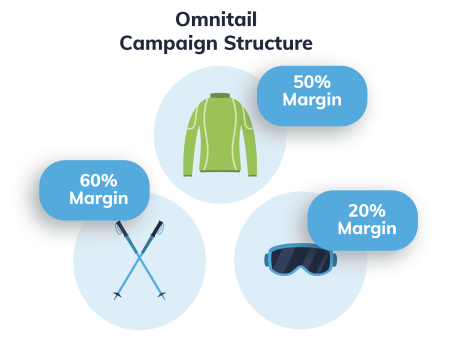
BACKGROUND
Saint Bernard is a leading retailer of luxury ski apparel. They had been advertising with Smart Shopping campaigns for more than a year, but revenue had hit a wall.
They struggled to grow sales and worse, they weren’t effectively driving profit—so they turned to Omnitail to help them restructure campaigns and increase profit!

48%
Increase in Revenue
Year/Year
63%
Increase in Profit
Year/Year
49%
Increase in Orders
Year/Year
INVESTIGATING
THE ACCOUNT
When we took over this account, we realized two things. One, that the Smart Shopping program Saint Bernard had was structured far too broadly to direct ad spend efficiently. Second, the current structure did not account for available margin, and therefore could not grow profit.
1. Inefficient Campaign Structure
First, we found that Saint Bernard was utilizing a very simple Google Shopping structure, with only one campaign. Many agencies prefer to load a large number of products into each Smart Shopping campaign, thinking that it gives the system more data with which to improve performance. In reality, this strategy simply limits the agency’s ability to identify poor-performing products and adjust bids to limit wasted spend.
2. Lack of Profit-Driven Management
This retailer’s campaigns had one other big problem: they weren’t built to maximize profit. Their structure did not take into account available margin, so it was impossible to know how much profit each campaign was driving, let alone adjust bids to ensure profit was maximized.
Omnitail's Advertising Strategy
We knew we had our work cut out for us to improve our Saint Bernard’s campaigns. What they needed was a Smart Campaign strategy that could ensure future growth—and our analysts were up to the challenge!
All-New Campaign Structure
We started from the bottom up rebuilding this retailer’s Smart Shopping campaigns. The first thing our analysts did was segment products by available margin, so we could base the structure around profitability. Grouping products into campaigns this way means each product in the campaign has the potential to generate profit at the same rate. This takes the guesswork out of bid adjustments since we know exactly how much profit is being driven by each segment.
Now, our analysts can adjust the ad spend to ensure that profit is maximized. We also segmented out our client’s top-selling products, recognizing that these high-traffic items can often skew the data for less-popular products. Our analysts can manage these items much more effectively if they’re separated from the rest of the inventory. Smart campaigns are a big part of our strategy—but they aren’t the full story! We’re also running traditional campaigns side by side with the Smart campaigns. This improves inventory availability, as all products can be more efficiently advertised.



Turning TROAS into Profit
One major problem with Smart campaigns is the lack of advertiser control. There are a limited number of ways in which campaign managers can adjust campaigns to curtail wasted spend or improve performance. Our analysts developed a way to convert target contribution margin (or, the benchmark at which profit is maximized) into a target ROAS. Each product segment has its own target ROAS, which can be adjusted. This strategy, paired with intelligent budget limits, effectively prevents overspending within the account.
GROWTH REACHES NEW HEIGHTS
Saint Bernard had hit a wall with their Smart Shopping campaigns when they turned to Omnitail to improve campaign performance. With a new campaign structure and a profit-driven strategy, this retailer is now on track for continual growth, even years into the future!






